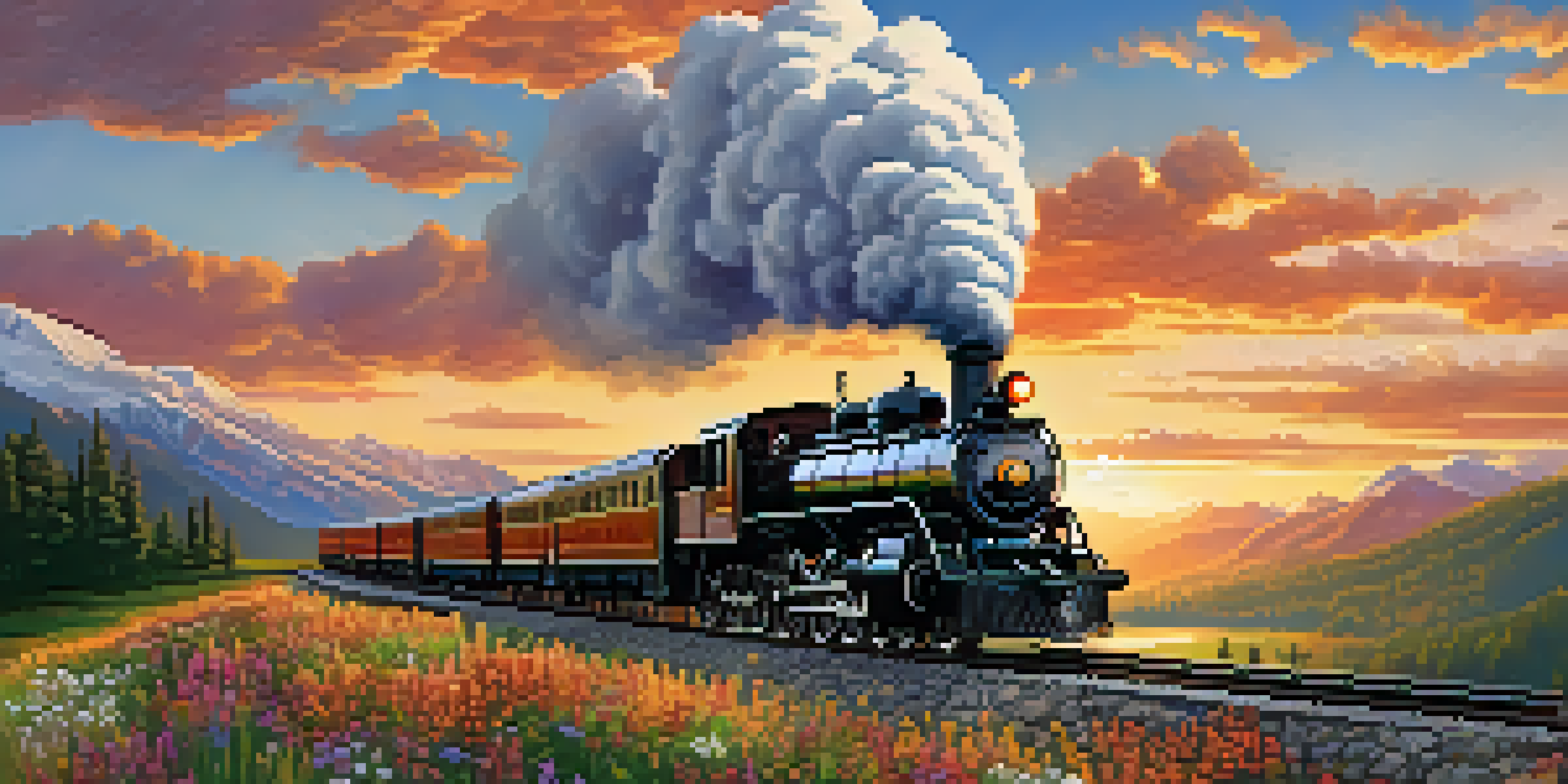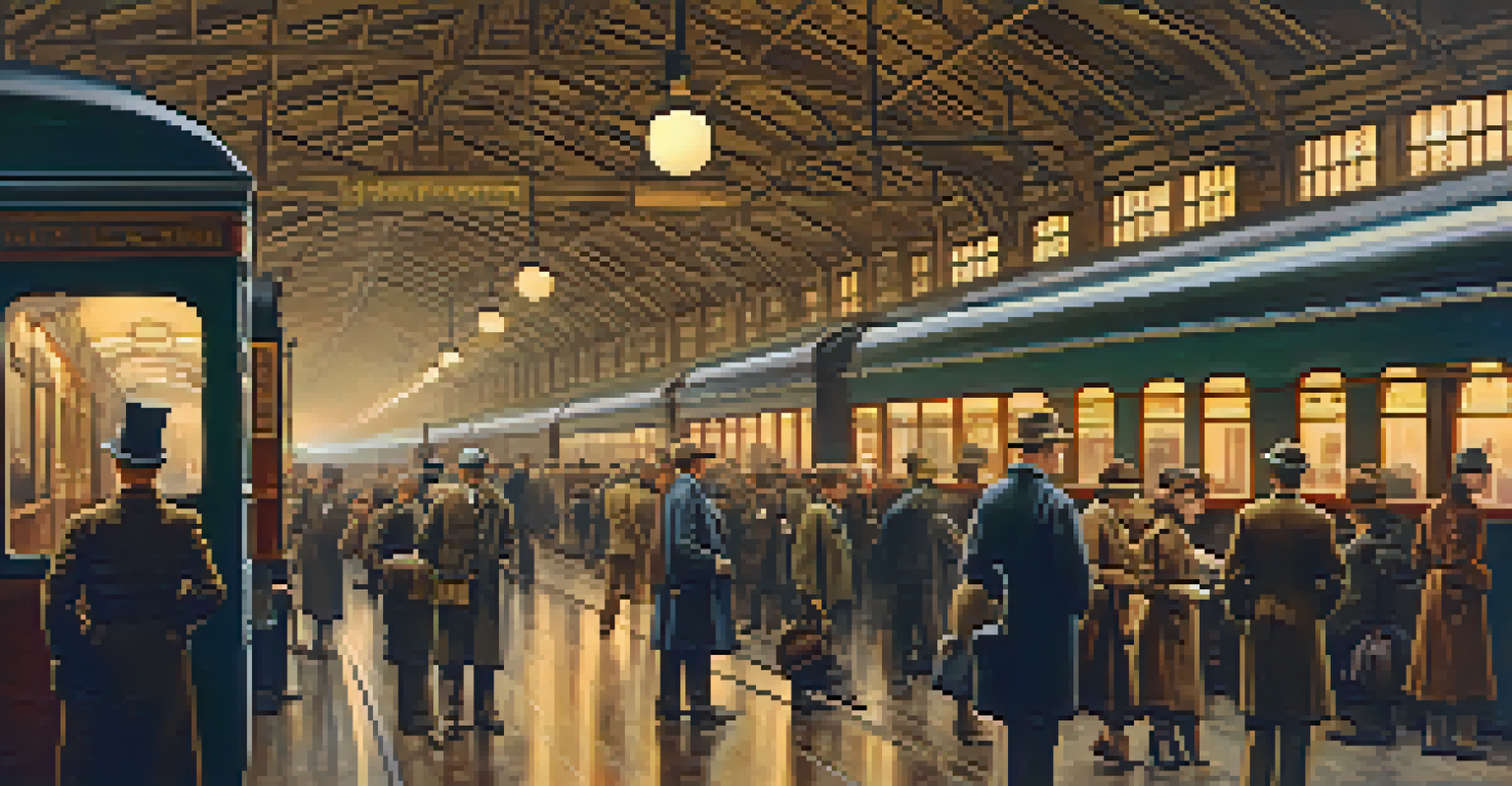Railroad Tourism: How Trains Shaped America’s Landscapes

The Birth of the American Railroad System
In the early 19th century, the United States was a patchwork of territories and settlements. The introduction of the steam locomotive revolutionized travel, connecting distant regions and fostering trade. Railroads became the lifeblood of the nation, facilitating the movement of people and goods across vast landscapes.
The railroad is a more effective means of transportation than any other means of transportation that we have.
The first successful passenger train, the Tom Thumb, demonstrated the potential of rail travel, sparking interest and investment. Soon, ambitious projects like the Transcontinental Railroad emerged, uniting the East and West coasts. This monumental achievement not only transformed commerce but also made travel more accessible to the average American.
As railroads expanded, they played a vital role in shaping the American identity, enabling exploration and adventure. Families could now embark on journeys to national parks, landmarks, and bustling cities, igniting a passion for travel that would endure for generations.
The Scenic Allure of Train Travel
One of the most enchanting aspects of train travel is the breathtaking scenery that unfolds outside the window. From the majestic Rocky Mountains to the serene landscapes of the Midwest, trains offer a unique vantage point to appreciate America’s natural beauty. Unlike flying, rail travel invites passengers to slow down and savor the journey.

Many railroads capitalized on this allure by creating scenic routes, complete with observation cars and panoramic views. The Glacier National Park route and the California Zephyr are just a couple of examples that showcase America’s stunning vistas. Travelers often find themselves captivated by the changing landscapes, making memories that last a lifetime.
Railroads Transformed American Travel
The introduction of railroads revolutionized transportation, connecting distant regions and making travel more accessible to all Americans.
Moreover, the nostalgic charm of vintage trains and historic railroads evokes a sense of romance and adventure. This blend of scenic beauty and historical significance continues to attract tourists eager to experience the magic of train travel.
Cultural Impact of Railroads on American Society
Trains have profoundly influenced American culture, shaping everything from literature to music. Writers like Mark Twain and Jack Kerouac celebrated the freedom and adventure of train travel, embedding it in the fabric of American storytelling. The rhythmic chugging of trains even inspired countless songs, reflecting a sense of wanderlust that resonates with many.
Trains are a reminder that the journey is just as important as the destination.
Beyond the arts, railroads also played a crucial role in shaping communities. Towns sprung up along railroad routes, transforming once-isolated areas into bustling hubs of activity. This development fostered a unique blend of cultures, as immigrants settled in these new communities, bringing their traditions and stories.
Thus, railroads didn't just transport goods and people; they wove a rich tapestry of cultural exchange that enriched American society. The legacy of this cultural impact is still felt today, as regions celebrate their railroad history through festivals and museums.
The Rise of Railroad Tourism
As travel became more accessible, railroad tourism emerged as a popular recreational activity. Scenic train routes and luxury rail travel attracted tourists seeking unique experiences and breathtaking views. This new form of tourism offered a chance to explore America’s diverse landscapes while enjoying the comforts of onboard amenities.
Railroad companies began to understand the value of tourism and invested in special excursions and themed journeys. From wine tours in California to fall foliage rides in New England, these tailored experiences allowed travelers to appreciate regional attractions in a leisurely way. The rise of railroad tourism opened doors to economic opportunities for many communities.
Train Travel Offers Scenic Experiences
Traveling by train provides breathtaking views of America's landscapes, encouraging passengers to savor the journey rather than rush to their destination.
Today, railroad tourism continues to thrive, with scenic trains and heritage railroads enticing visitors from around the world. The romance of the rails endures, inviting everyone to hop aboard and create their own travel stories.
Sustainable Travel: The Eco-Friendly Benefits of Trains
In an era where sustainability is becoming increasingly important, trains stand out as an eco-friendly travel option. With lower carbon emissions per passenger compared to cars and planes, trains offer a greener way to explore the country. This aspect appeals to environmentally conscious travelers who want to reduce their carbon footprint.
Many rail companies are adopting sustainable practices, such as using renewable energy sources and implementing energy-efficient technologies. These efforts not only contribute to environmental conservation but also enhance the travel experience by promoting a connection to nature and local communities.
As travelers seek more meaningful experiences, the environmental benefits of train travel align with a growing desire for responsible tourism. Choosing trains over other modes of transportation can help preserve America’s landscapes for future generations to enjoy.
Iconic Train Routes and Their Stories
Some train routes have become legendary, each with its own unique story and charm. The Orient Express, for example, has long been associated with luxury and intrigue, while the Amtrak Coast Starlight showcases the stunning Pacific coastline. These iconic journeys offer more than just transportation; they provide a glimpse into the heart and soul of the regions they traverse.
Travelers often find themselves enchanted by the rich histories and narratives tied to these routes. From the Gold Rush era along the Sierra Nevada to the Civil Rights movement's impact on Southern trains, every journey tells a story. These narratives enhance the travel experience, allowing passengers to connect with the places they visit on a deeper level.
Railroads Fostered Cultural Exchange
Beyond transportation, railroads shaped communities and cultures, enriching American society through the blending of diverse traditions and stories.
As more people seek unique travel experiences, these iconic train routes continue to captivate the imagination, inviting adventurers to embark on journeys filled with history and wonder.
Future of Railroad Tourism in a Modern World
As we look to the future, railroad tourism is poised to evolve in exciting ways. Advances in technology may lead to enhanced travel experiences, such as virtual reality tours and improved onboard services. This modernization aims to attract a new generation of travelers while preserving the nostalgia that makes train travel special.
Additionally, there is a growing trend toward combining train travel with other forms of eco-friendly transport, such as electric buses and bicycles. This multi-modal approach allows travelers to explore destinations more holistically, promoting sustainable tourism practices.

Ultimately, the future of railroad tourism lies in balancing innovation with tradition. By embracing new technologies while honoring the rich history of trains, we can ensure that this beloved mode of travel continues to inspire and connect people for years to come.